Part 1⁄7 What is a Qibla? Where did the first mosques of Islam face?
Transcript
Hello. I’m Dan Gibson and this is the first video in a short series about the Qibla. I thought I would go through a couple of different videos and will tell you the story of the Qibla, as I see it, and try to explain the way, and the things, that I have discovered now. Forty years ago I started studying the Arabian Peninsula, and the history of the Arabian Peninsula. I was interested in the Nabataean people - the people who built the ancient city of Petra. So, I studied and I prepared myself and went out to the Middle East. I made a lot of visits to the city and to the surrounding area. Over the last 40 years that was the focus of my studies.
However, the last ten years I became interested in the study of early Islam. You see, what I had done is I had been studying the early history of the Arabian Peninsula and I had looked at the Edomite people and then at the Nabataean people, and others in the area. I had spent almost four years in Yemen studying and learning about the Yemeni background, and also trying to understand the culture of the Yemenis. So it was more than just the history, but also, “Who are these people? How do they think?” Over those years I also spent time out with the Bedouin, and the deserts, just sort of immersing myself in the culture, the thought patterns, and the history of the Arabian Peninsula. I realized quite early on (well, maybe after 10 years being there at out of 40 years) that there were some problems with Islamic history. I could see it from a distance, sort of, because I had studied the history of the Arabian Peninsula. That’s what I was doing, and as I was coming forward, having studied the time under the Greeks and under the Romans and so forth, moving up to the Byzantine Empire, I began to realize my understanding of the Arabian Peninsula was quite different from what I understood of the history of Islam.
See, in Islam, you work your way back. We know where we are today… we go back to Mohammed, who is the founder of Islam, and as we go back it described Arabia at that time. The setting didn’t seem to fit. There was there was some sort of problem. I said, it’s kind of like two ships coming, and they they’re passing behind, but they should be meeting, and they seem to go right by each other. There was something about the history, and I would tell my friends, with people I’m studying, and said, I don’t want to touch early Islamic history because there is something here and it’s going to take an awful lot of study. I mean a lot of study. I mean, I could look at everything but there was there was something here that I realized if I’m going to dig into this it’s going to take all my time, all my energy; it actually means a shift of what I’m doing and what I have planned to do in order to focus on this problem of early Islamic history. So, eventually several people pleaded with me, “Look into this you! You keep talking about it, but when are you going to take time to actually study this, and look into it?”
It wasn’t until the year 2010 that I had the opportunity to take a sabbatical and have one year for my own personal study and pursuit. I decided, “Okay. I’m going to start at the beginning of the school year in September, and I am going to really dig into this.” So, we had things set up so I could spend as much time as I wanted in study. I took it, I often spent 10 to 14 hours a day just pouring through this problem, looking at what do I know, and why am I uncomfortable? Why do I feel some of these things don’t fit? I recognized early on it was a problem of geography. The geography I’m reading about the Nabataeans ending, the Byzantines coming in place, and then the geography I’m reading about early Islamic history… there was something there that wasn’t right. So, I started in 2010, and very quickly, within a few, within I think three weeks of starting on this, I realized one of the issues that I needed to tackle was that of the Qibla question.
You see, I had become uncomfortable with the question of the Qibla over the last years before this. I was aware that the Qibla was changed by the Prophet Mohammed - he came, and when he moved to Medina he was in Medina. We have the dates of when he arrived. About 17 months later he announced that the Qibla would change. Now, this was interesting from many different angles. One of them is the word Qibla. Where does the word Qibla come from? It’s not a word that is used by anybody else. It’s only used in the Quran. It seems to refer - if you read the Quran, and try to read the early writers - it referred to the direction one faced when one prayed. That’s as simple as it was. It’s the direction you faced when you prayed. People would pray always facing towards the Qibla direction. Eventually, it was used for more things, such as when a person kills an animal. If he faced towards the Qibla direction, and slit the throat of the animal, and drained the blood, then it was done in a halal way.
So, the Qibla direction was important for everyone. The earliest records of the Qibla, and the word Qibla, come from the Quran. We don’t go to the Hadiths, or to others. We can go directly to the Quran. We can discover the word Qibla in surah chapter 2. It’s very plain that the Qibla direction was changed from its original direction to Masjid al-haram. That’s all it tells us. It doesn’t mention the Ka’ba; the Ka’ba is not mentioned there, the Black Rock is not mentioned there. It simply is, “Turn your face now to a Qibla that God is giving to them.” He said, “This is a good Qibla. This is something you’ll be happy with, turn towards Masjid al-haram.” So that’s all the instructions were given.
Now, other religions don’t have a Qibla in the same sense. There isn’t a holy direction for them. The earliest we might get a hint of this is when Solomon is dedicating his temple, the Temple in Jerusalem, and he prays. During that prayer he prays, “God, if anyone turns his face towards this temple, where you have put your name, then I you know bless them and hear their prayer.” This is the first concept we have that if people turned and prayed towards of the Temple in Jerusalem, where the name of God is, that Solomon asked that God would bless them. It’s not a command from God and Jews don’t have to face Jerusalem. They don’t feel like they have to figure out where Jerusalem is or God won’t hear their prayer. It was in a prayer of Solomon’s that this was first mentioned. Later on, it became common in the churches (Christian churches), as Christianity grew up, that people would face East. This is particularly important in the graves simply because Christians were buried on their back and put down. The idea was, that when Christ returned, he would return in the eastern sky. So, they laid the body down in the grave - the idea was when the body sat up on Resurrection Day it would face East. So the feet always were pointed in the eastern way. Some churches are oriented towards the east, but not all churches were. There’s no command in Christianity to face east. It’s simply a tradition that developed over time.
Muslims are unique in that they have this holy direction, or this Qibla, this direction you face. It is common among Muslims to think, “Oh yeah, everybody… all these other religions have a Qibla.” They’re often quite surprised to discover that the Qibla is not generally understood in other religions. Especially among Protestants, who are totally clueless about direction and so forth because it comes out of tradition. The Protestants have, in many cases, cast off tradition and they have returned back to just the words of Holy Scripture. For them, if it’s not written in the Old and in the New Testament, then it’s not important. God would put only what was important in those books. Since those books don’t mention the Qibla, or a direction of prayer, it is very not important to those who are holding to the Word of God, to the Bible, as their direction, and have ignored a lot of the tradition that has developed in the churches over the years.
So, the word Qibla is a Muslim concept. It comes to Islam, and when the Quran speaks of it, it assumes that people know what the Qibla means. We have no real archaeological records, though, of the early Qibla. We are simply told that the message came to Muhammad. Muslim historians and scholars have worked out the date to the 11th of February 624 A.D. This is the first year in the Islamic calendar, and this is the year when the Hijri took place. 17 months later comes the 11th of February, in 624. Muhammad receives a message from God that they should change the Qibla direction … so that message goes out. We know that it came quite early on. Maybe the first place it came was to the people who were in the mosque in Quba (there, it’s a village just outside of Medina). They stood up, turned around, and faced towards Mecca. That’s what we’re told.
Now, the problem is, as we read the Hadith, and the histories, different terminology comes out. You see, the problem is that there’s no archaeological record for this. We don’t have the early mosque, and where it faced; then, the next mosque and where it is. We can’t go back and look at stones. We’ll talk a minute about the different mosques, but, to be absolutely certain, that is a problem. We don’t have any writers of the time actually writing down what took place. The writers who write down are a generation, or even two generations later, and they don’t all agree. Some of them say he was praying towards Alkyds (which would be Jerusalem). Some say he sprang towards al-sham, which could mean north, or, it could mean Damascus. There is no agreement. Even the same writers will quote different Hadith and have different directions in there. So, I recognize this was a problem. Now, the biggest problem I had was that, as I had been traveling around the Middle East, and when I would go to a place, I would try to understand the entire history that was there. When I was in a city, I wasn’t just looking at early history - I was looking at the early history of the Islamic history. I mean, what could I learn while I was visiting this site, or this city, or whatever. I became aware that a number of mosques I had gone to visit, that the curator of the mosque, or the guide who was there, would say, “This mosque originally faced towards Jerusalem, and then later it turned and it faced towards Mecca in Saudi Arabia.” I would make a note of that and just move on.
Later on, I realized I’ve seen a lot of mosques… I mean, I thought in 17 months, when Mohammed moved to Medina, he brought his people there. There are virtually no other Muslims in other places. There may have been a few left back in the original holy city. There might have been a few who went other places, but generally, you would only look for the early Muslims, according to their history, in Medina. There might have been a few Muslims who had stayed in Ethiopia and there might have been a few who had gone somewhere else. But the question is, I mean, how could there be a mosque in Oman (or several mosques in Oman) that faced Jerusalem and later faced towards Mecca in Saudi Arabia? How about these others? I began to realize, “Wait a minute… something doesn’t make sense. In 17 months did they build these other mosques?” So I began to realize I have to study the Qibla direction, and in order to study I need to look and study the early mosques because they will give me some sort of indication of when this date took place. I recognized the problem is the date. Islamic history gives us only 17 months. I began to visit these mosques and began to chart them. I have a GPS unit that I used (a very early one), going out trying to determine that. Fortunately we also had some satellite photos that were becoming available. I could use the technology that was available and began to look at that. I began to recognize that they were pointing different places. It was early on. I mean, I started in September, and I remember in November I said to my wife, I said, “You know when I started out I thought maybe this whole thing about the Qibla was going to be some sort of, conspiracy theory that I would write up. But I’m finding so much information that I’m beginning to question - Is this actually true? I mean, I thought I was going to just write, ‘Here’s a possible explanation’, but I’m starting to look at this and say, you know, there is a lot of evidence here!”
I began to put together the evidence and started building a database, trying to figure out. I started with just a spreadsheet. I originally thought I was only going to have to look at four or five mosques; that should solve the problem. The problem got bigger, and bigger, and so I started collecting more and more information and eventually I started making a list. At the end of that year I produced the book Quranic Geography. It was not about the Qibla direction; it was mostly about the history of Arabia that I had been studying and looking at and gathering notes for some, you know, twenty years, or almost thirty years before that. So the thing about the Qibla and the direction was tucked away at the back of the book. It was just a question that came up, and at that point I had drawn lines and maps. I had gathered information and I had recognized it seemed that the early mosques all faced towards the city of Petra, in Jordan, and not towards Jerusalem, or towards Mecca. I hadn’t found any mosque towards Mecca until much, much later. I didn’t, at that point, didn’t even recognize there was a “between mosque”. If you read Quranic Geography it’s the initial discovery of the Qibla and the questions of the Qibla. So far, I realized I had to do more study, but I wanted to introduce it. I wanted to hear back from other people and to see what they said, what their explanation was.
So what I’d like to do is at this point is, I’ve got a couple mice here in a couple computers. I’m going to take us over to this the early Qibla tool that we have, “The Qibla tool” So, we’re turning our attention here you’ll see somewhere here, my mouse, there it is, is moving on the map. Here you can see (down here) is the city of Medin,a and up here we have Petra and we have Jerusalem - they are in much of the same direction. Now, please remember, the early Muslims did not have GPS units. They could not accurately within, you know, a degree, or a fraction of a degree, determine the Qibla direction. They used what was called The Arab Compass, which was the rising and setting of certain stars. So, in the evening certain stars would rise, they would go across the horizon, and then they would set. Direction was calculated using the rising and setting of these difference stars. There were two hundred and twenty-four different stars that rose over and went down. They could measure this, but in today’s calculation, they were good if they were within three or four degrees and that’s quite common to when we checked the early Qibla, so it wasn’t always exact. Now here we can recognize that the mosques (the early mosques) were in Medina. If you look up here on the right you will see the Quba mosque (which is in Medina), the Prophet’s mosque (which is in Medina) the mosque of the two Qiblas this is Qiblatain mosque of Qiblatain (the tain means that the two, the doubling of it), you have the Janad mosque as well, and the Jowtha mosque. So all of these mosques were built within the first eight years of the founding of Islam.
Our problem with this is that none of these mosques are conclusive in where they point. Now (if you look at what I’ve got on the right), we have Quba over here, which is where the announcement was made. Muhammad had decreed to change to the mosque, the Prophet’s mosque is where he was when he made that announcement, and the Qiblatain mosque… now this is an interesting mosque I’m going to just click on it here. You’ll see (you can click on any of these), but let me click on it, and we’ll come back down here, and this is the Qiblatain mosque today. Now if you look over here on the right we have the Qibla towards Petra, or the direction towards Jerusalem on green, towards Mecca. You will see that this mosque aligns to Mecca today, straight down the line, goes towards Mecca. That lines up with the building and so this building (if you’re facing this long wall here in within the mosque), you are facing towards the city of Mecca. Now the problem is this is a very modern building. If we click down here (on more information) it will take us over here and tell us that this mosque, which was built in the year 5 after the Hijra, it was rebuilt in 88 after the Hijra. In our modern date 1987 was the last major construction. So when you’re here looking at this mosque you’re looking at something that was built in 1987. The original foundation of this mosque no longer exists. If you go and visit this mosque, there is no evidence of where it was.
However, there is something about this mosque that is good and exciting, and that is that when this mosque was in construction in 1987, the people who were digging of the mosque came across the foundation of the original mosque. They looked at it. There’s Abdul Wahid Wakil - he was an engineer and architect who was there. He made drawings as soon as they uncovered it. He got in and made some drawings of this. So, we have a record of that early foundation and indeed, it did face north. Now those stones were gone; they removed it. All we have is this record and, unfortunately, it’s very difficult to tell within a couple of degrees how this drawing is oriented, and what direction it actually faces. You see, at the time, there was no question about the Qibla. They all understood the Qibla faced towards Jerusalem. Here we have evidence - we dig down and this mosque had two Qiblas at this point. One faced towards Jerusalem and one faced towards Mecca. So, it’s the Qiblatain mosque. Let’s go back and look at this though. The problem here that we have is that we don’t have any good measurements from 1987. It was just assumed that faces towards Jerusalem. So what do we do when we back up, and we look at these, and we see that the line goes up here, and it faces here. Now here’s the question: Does it face Petra? Does it face Jerusalem? How do you line up these drawings? In my mind, at least, it points closer to Petra than to Jerusalem. However, when I have tried to figure out, or put into the database, I put Jerusalem and Petra. You could argue that this pointed it to Jerusalem. You could argue it pointed it to Petra. The problem is we’re only dealing with one measurement. So, a lot of people come, “I want to know!”, and they start working at within the half a degree, or a fraction of a degree and things. That to me that doesn’t make any sense. They didn’t have the technology to get it within a fraction of a degree. If they did, they were fortunate. If they didn’t, they were out 2 or3-degrees, even of as much as five (the average is about three degrees), within three degrees of where they wanted to point.
So I refuse to classify this, and say, “This points towards Petra.” The strength of it is, if I change and if I come over here now, I was doing this if you look back on this map, under the age of Mohammed. Let me go over here because I can pick, “Muhammad’s mosques built during Abu Bakr’s time”, “Mosques built during Umar’s time, or Uthman’s time”, then the Umayyads up to the Second Fitna. This is when they built. Then, during the Second Fitna (the second civil war) mosques are built at this time. Then the Umayyads who built after the Second Fitna; the Abbasids, and then that split time, Abbasids on one side, Umayyads on the other, looking particularly at North Africa and Spain. That’s the last one But let’s go over here and let’s look down and let’s show what points towards the city of Petra. Because these, you will notice, are all again there are 15 after the age of 21, 78, and so forth. So most of these at the top are built within a hundred years (the first hundred years of Islam). So there’s actually, if you go down, you’ll start to begin to see we’ve got, I’ll have to count them - one, two, three, four, five, six, seven, eight, nine, 10, 11, 12, 13, 14, 15, 16, 17, 18, 19, 20, 21, 22 different mosques. So we’re not measuring one mosque - we’re looking at 22 different mosques that appear to point to southern Jordan. So if you come over here (to this map) you can see that here in the middle is the city of Petra. Here are the Qibla, some of them end up going south away. Some of them end up going north away. This down here is for Humeima, and so it’s 27 miles from Petra. I mean, we’re talking in a circle this big. Some of those mosques are quite far away and they’re pointing up in this direction.
The challenge here is not to get down to within a degree or a fraction of a degree. The strength of this argument is on 20, over 20 mosques, that point, face this direction. Their Qibla faces here. Dr. King, and others who argue against me, say, “Well, these mosques all faced south.” I agree they face south, but there are also some from the east, some from the west, and some from below, who are facing north. They’re pointing in this direction. That led me to suddenly realize the city of Petra, where I had spent a lot of time studying, was the focus of the Qibla! That was a, “Eureka!” moment for me. But it’s also a very sobering moment, because I realized, “How in the world am I ever going to prove this?” It seems very convenient that I had spent twenty years studying the city of Petra, and of the Nabataean people, and tracing their whereabouts. Suddenly, when I’m studying Islam, Petra suddenly pops up as being an important place.
It may seem a bit convenient, but I mean, I had a hard time believing it. In fact, I went around for the next couple of years trying to disprove what I had found. In fact, that back when I was in that first year, I spent quite a bit of time trying to disprove that I had discovered this Petra thing. I have all these other mosques that later became between. I didn’t know they all exist; I only knew a couple of them were off by at least eleven to twelve degrees. So, my circle was much bigger than that around Petra. It wasn’t until much later I discovered the between-mosques and then that isolated that group, and left us with the Petra group. So, we’ve got 20 different mosques that we can look at, we can measure and that gives us the data with which we can gather and say, “I don’t think this was a mistake. I don’t think this was chance. This is not just talking about one or two mosques. We are here talking about a pattern that fits.”
Now notice in those early years (and you’re looking up here on the right), you’ll notice that none of these point towards Petra - I mean, Mecca in Saudi Arabia. The first ones are all unknown. Abu Bakr’s time there’s only two different places here and they are also unknown. If I go to Umar’s time - here’s Petra – unknown – unknown - because unknown means they were rebuilt. So we can’t measure because the mosque is gone. When we get over here in Uthman’s time, they’ve also all been rebuilt. So we get to the Umayyads here, and again they’re all Petra, but there’s a few unknowns. We can’t quite tell but these are all facing… What’s important here is we are now working up to the second civil war and not a single mosque has pointed to Mecca in Saudi Arabia. Now, that was shocking to me, and it should be shocking to you, because here we are, up to 80 years after the Hijra, and at this point still every mosque that has ever been constructed in Islam, that we can measure (that’s the important thing, those that we can still measure) point to the city of Petra. All the big important mosques that we have today, like Qiblatain and Quba and others, they’ve all been bulldozed, knocked down, rebuilt. We cannot measure that original Qibla. So, if we get to the one after the civil war, when we’re getting to the years after (they’re lined up here, 81, 86, 87 after the Hijra, 90 after the Hijra). Now, some of these are between, but, but, where is Mecca? When are we going to come to a city that is facing Mecca? Ah! There it is. We have one here, which is a hundred and twelve years after Mecca. I should have had one before. Where is it? Okay, we’ll see Mecca begin to show up here as we go along. So there are questions here. Then, under the Abbasid time, then we have all these different Mecca mosques, and suddenly Mecca becomes one. Now there’s one… Jerusalem here. We’ll talk about it later, but these… the pattern that I wanted you to see, is that mosques built towards Mecca begins 109 years after the Hijra.
So basically, in the first 100 years of Islamic history, not a single mosque faced towards Mecca in Saudi Arabia. Now Dr. King and others in his group of scholars have said, “Well, this is because they measured the Qibla differently. This is because they weren’t facing Masjid al-Haram. They were people had gone to Mecca. They have been there they had picked up some direction there. Maybe they had stood on one side of the Qibla of the Ka’ba building, or another.” He said, “Well actually then,” then he said, “it’s not Masjid al-Haram that they’re measuring, they’re measuring the actual Ka’ba building and the way the building is oriented, and maybe they took a measurement off of this corner, or off of this wall, or whatever, went back to their home countries and then did that.” That’s his possibility, and that is based on the medieval people writing some couple hundred years later (some of them four or five hundred years after the fact), and that’s what they came up with in the time of the medieval. Muslim scholars who were trying to answer, “Why does this mosque in my hometown seem so strange?” But when we back up, and when we look at the city of Petra, and we have a look at this, we discover all of these different mosques that are facing towards the city of Petra.
Okay, that’s the beginning. Petra was the focus and I have got videos tapes we’ve made here. You can look on them and see how we’ve talked about different evidence. In the book Early Islamic Qiblas, I’ve gone back and had a look at the different evidences that would support this. Because well, after I looked at this I said, “I’ve got to reread Islamic history.” I went back and began pouring through al-Tabari, pouring through the writings of Ibn Hisham and Ibn Ishaq and others, trying to put together this history and what happened there, and is there any hint that there was pointing towards, they were praying towards the city of Petra? Well, I’ve come up with over 50 different evidences. They’re just supporting evidences. The actual argument is based on Qibla directions that we have been able to go back and measure (based on the teaching of the Quran and in surah chapter 2, that Muslims were to face towards Masjid al-haram). As I have pointed out later, and in some of the other videos, we’ve gone back and have identified Masjid al-Haram in the city of Petra. We’ve even identified what appears to be the Ka’ba building… the original structure! It’s measurements match exactly those of Azraqi and others who have described the first Ka’ba building during the lifetime of Muhammad, even giving measurements of the lengths of the sides. There’s four different lengths because the building wasn’t exactly square. It was off on an angle a little bit, and different measurements. We found the foundation of a building that fits that, and as we look at it, this looks like the original Ka’ba building. We’re going to talk about that a little bit.
On this state, all we’re covering is the question about Jerusalem, and introducing the topic of Petra. All I can find… I have no solid evidence for Jerusalem. They might have prayed towards Jerusalem. Only Bukhari and a few others, writing three hundred years after the fact, mention it. So was it there? Was that a sham? Was it Damascus? Were they just praying north? That is not clear. We can’t identify that in stone, in foundations of mosques, that has all been erased. What we do have is over 20 structures, out of about another 20 more, that have been destroyed from the first hundred years of Islam (that’s a lot of buildings that have survived from that time to now). All of those Qibla seemed to point towards the city of Petra. Then, something happened, and that’s what we’re going to look at in the next video. Then we’ll continue on there and the story of the Qibla, and how it changed, and how it got to Mecca today.
Thank you, I’m Dan Gibson. This has been another video, and the first video in a series on the Qibla Story.
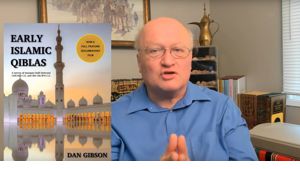
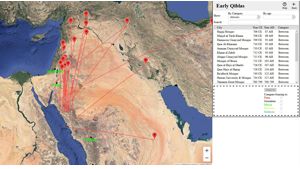
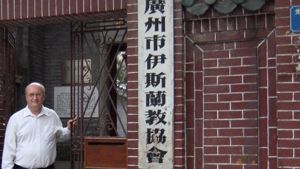
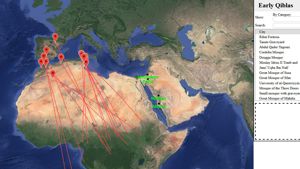
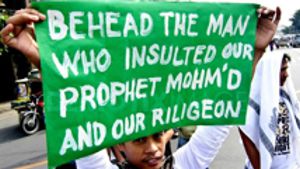
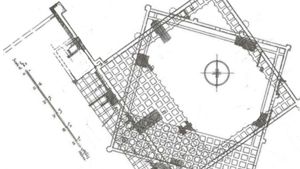
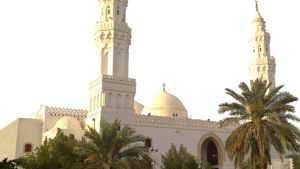
Page Discussion
Membership is required to comment. Membership is free of charge and available to everyone over the age of 16. Just click SignUp, or make a comment below. You will need a user name and a password. The system will automatically send a code to your email address. It should arrive in a few minutes. Enter the code, and you are finished.
Members who post adverts or use inappropriate language or make disrespectful comments will have their membership removed and be barred from the site. By becoming a member you agree to our Terms of Use and our Privacy, Cookies & Ad Policies. Remember that we will never, under any circumstances, sell or give your email address or private information to anyone unless required by law. Please keep your comments on topic. Thanks!